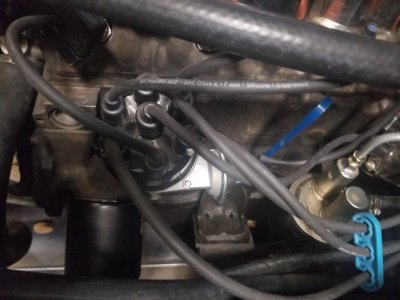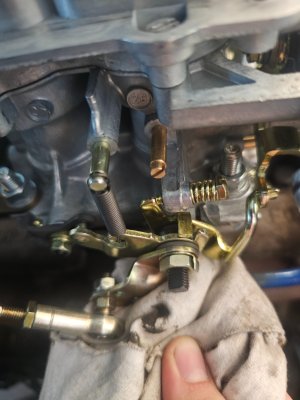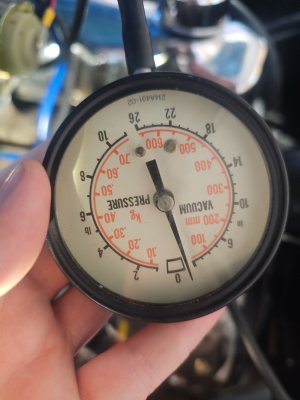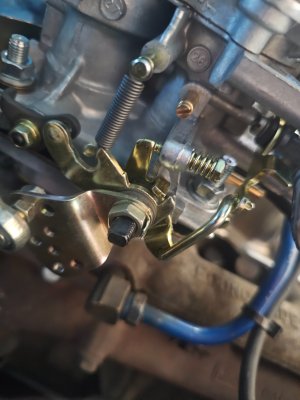You are using an out of date browser. It may not display this or other websites correctly.
You should upgrade or use an alternative browser.
You should upgrade or use an alternative browser.
All Small Six Weber 32/36 rough idle
- Thread starter beanmiester
- Start date
This relates to all small sixes
All wires are going to the right place. It wouldn't run as well as it does with the vacuum off if that was the case.Also ensure that the firing order is clockwise.
I had my grandpa take the pic because I'm out so hopefully this will work. I have no idea what brand it is. A shop put it in when they broke mine and just had it listed as "distributor" on the billI don’t think we ever determined what distributor you have now. A quick photo, with the advance canister, would help.
Attachments
62falcon wagon
Active member
Where are you pulling vacuum from. Manifold vacuum is high at idle, advancing timing at idle. Then vacuum drops as throttle opens decreasing timing advance.
Ported carb vacuum is nil at idle and increases as throttle opens thus advancing timing as needed.
Without identifying distributor what you need
Ported carb vacuum is nil at idle and increases as throttle opens thus advancing timing as needed.
Without identifying distributor what you need
Also thank you all for helping. This is
I'm taking vacuum from the port on the carb for distributors. I belive that is portedWhere are you pulling vacuum from. Manifold vacuum is high at idle, advancing timing at idle. Then vacuum drops as throttle opens decreasing timing advance.
Ported carb vacuum is nil at idle and increases as throttle opens thus advancing timing as needed.
Without identifying distributor what you need
Yes, that is ported and the right one for a typical vacuum distributor like the DUI unit. If it pulls vacuum at idle, you have the idle screw turned in too far. Webers are particular about that (I have a 38/38 on mine).Also thank you all for helping. This is
I'm taking vacuum from the port on the carb for distributors. I belive that is ported
Here, look at this and follow it. It’s about the best way to get your Weber idle sorted out with the appropriate distributor. http://www.redlineweber.com/html/Tech/carburetor_set_up_and_lean_best_.htm
I am still uncertain about your idle timing.
Do this: (if you haven’t already )
)
Unhook vacuum from distributor, plug the hose, check timing. ( this is base timing )
Plug hose back in to distributor, note timing again.
Rev engine to 2500 to 3000, while looking at timing, this will show you timing being advanced by distributor ( when it stops increasing, that is total advance )
These numbers will give you a pretty good picture of how your vacuum advance is working. Do this again when you get the DUI installed. Post numbers and further advise can be given at that time, if needed
Do this: (if you haven’t already
Unhook vacuum from distributor, plug the hose, check timing. ( this is base timing )
Plug hose back in to distributor, note timing again.
Rev engine to 2500 to 3000, while looking at timing, this will show you timing being advanced by distributor ( when it stops increasing, that is total advance )
These numbers will give you a pretty good picture of how your vacuum advance is working. Do this again when you get the DUI installed. Post numbers and further advise can be given at that time, if needed
" ... i just put on a weber 32/36 on my 66 200 "
.
howz 2Bbl mounted to intake (pics) ?, did engine ever run well before new carb with the Autolite carbs ?.
.
32/36 and H/W5200 clones were used in very different engines for a long period. The jetting and emulsion tubes will vary with intended OEM application from small @100 CFM to @ 300 CFM applications on inline four, six and V6 engines. Figuring what the OEM application or current jetting , air corrector , tubes etc. setup if new, will help shorten your 'tuning' fun.
.
 .
. 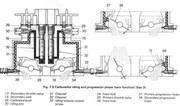
.

.
have fun
.
howz 2Bbl mounted to intake (pics) ?, did engine ever run well before new carb with the Autolite carbs ?.
.
32/36 and H/W5200 clones were used in very different engines for a long period. The jetting and emulsion tubes will vary with intended OEM application from small @100 CFM to @ 300 CFM applications on inline four, six and V6 engines. Figuring what the OEM application or current jetting , air corrector , tubes etc. setup if new, will help shorten your 'tuning' fun.
.
 .
. 
.

.
have fun
I am still uncertain about your idle timing.
Do this: (if you haven’t already)
Unhook vacuum from distributor, plug the hose, check timing. ( this is base timing )
Plug hose back in to distributor, note timing again.
Rev engine to 2500 to 3000, while looking at timing, this will show you timing being advanced by distributor ( when it stops increasing, that is total advance )
These numbers will give you a pretty good picture of how your vacuum advance is working. Do this again when you get the DUI installed. Post numbers and further advise can be given at that time, if needed
I was thinking the same thing. A timing light is a great tool to assess the initial timing and to make sure that the ported vacuum is not engaged when the carburetor is supposed to be on the idle circuit.
With the right idle jet or jets, it’s a pretty simple carb to tune for idle. The link I posted yesterday is a fast and effective method for getting it to idle. You can do it on the side of the road in a minute or two.
guys- forget not that he said hooking the vacuum line to the distributor caused the problem to magnify. To tell him, "yes that's ported" is premature, and I believe wrong based on the symptoms. I repeat my advice in post #14. Especially if a shop installed the distributor.
If the base timing is excessively advanced and the vacuum supply is inadvertently hooked to intake vacuum, the symptoms of rough/ misfiring idle when the advance is applied says: base timing is too early and vacuum supply is intake, not ported.
It takes 2 minutes to retard the distributor and see if the problem clears. This is where I would start, since the symptoms most closely mimic this cause.
If the base timing is excessively advanced and the vacuum supply is inadvertently hooked to intake vacuum, the symptoms of rough/ misfiring idle when the advance is applied says: base timing is too early and vacuum supply is intake, not ported.
It takes 2 minutes to retard the distributor and see if the problem clears. This is where I would start, since the symptoms most closely mimic this cause.
I was thinking the same thing. A timing light is a great tool to assess the initial timing and to make sure that the ported vacuum is not engaged when the carburetor is supposed to be on the idle circuit.
With the right idle jet or jets, it’s a pretty simple carb to tune for idle. The link I posted yesterday is a fast and effective method for getting it to idle. You can do it on the side of the road in a minute or two.
I checked timing without vacuum and it was 12. Retarding or advancing make the engine not so happy. With the vacuum hooked up the timing needs to be way way retarded. So that would be a setting issue messing with the ported vacuum or that the "ported vacuum" port is in fact not ported?guys- forget not that he said hooking the vacuum line to the distributor caused the problem to magnify. To tell him, "yes that's ported" is premature, and I believe wrong based on the symptoms. I repeat my advice in post #14. Especially if a shop installed the distributor.
If the base timing is excessively advanced and the vacuum supply is inadvertently hooked to intake vacuum, the symptoms of rough/ misfiring idle when the advance is applied says: base timing is too early and vacuum supply is intake, not ported.
It takes 2 minutes to retard the distributor and see if the problem clears. This is where I would start, since the symptoms most closely mimic this cause.
Thank you! that clears that up.I checked timing without vacuum and it was 12. Retarding or advancing make the engine not so happy. With the vacuum hooked up the timing needs to be way way retarded. So that would be a setting issue messing with the ported vacuum or that the "ported vacuum" port is in fact not ported?
If there is ANY vacuum on the end of the advance hose at idle it is either not ported, or the idle screw is opened up too far, enough to let vacuum through. Ported vacuum is same as manifold vacuum, but the internal port in the carb that creates the vacuum is just above the throttle blade at idle. Thus the vacuum pattern of a ported vacuum slot is: Zero vacuum at idle, as soon as the throttle opens a few degrees, vacuum signal goes from 0 to full manifold vacuum. Ported and manifold vacuum are the same at all open throttle positions. Ported is designed specifically to allow base timing at idle, then apply strong vacuum advance to the timing as soon as acceleration begins.
How about a photo of the vacuum port you’re using. A Weber 32/36 should only have one vacuum port and it’s at the front below the choke. If it pulls vacuum at idle, your idle screw is in too far. You can’t run it more than 1-1/2 turns in from just touching the throttle stop lever, otherwise it will start drawing vacuum and you’re off the idle circuit.
So I need a stronger return spring but by manually pressing on the throttle linkage my low idle is 550. But the port is pulling 12 vacuumHow about a photo of the vacuum port you’re using. A Weber 32/36 should only have one vacuum port and it’s at the front below the choke. If it pulls vacuum at idle, your idle screw is in too far. You can’t run it more than 1-1/2 turns in from just touching the throttle stop lever, otherwise it will start drawing vacuum and you’re off the idle circuit.
Attachments
Yes, that is supposed to be ported vacuum. It should be completely closed with no vacuum at idle.
How many turns in is the idle speed screw? You can back it up a quarter or half turn at a time, keeping track of how many turns it takes for it to just kiss the throttle stop lever without it opening the throttle blades. It should be no more than 1-1/2 turns.
If it’s less than 1-1/2 turns and it’s pulling vacuum, there’s a problem with the carb. If it’s more than 1-1/2 turns, you’ll need to do the best lean idle procedure I linked earlier.
How many turns in is the idle speed screw? You can back it up a quarter or half turn at a time, keeping track of how many turns it takes for it to just kiss the throttle stop lever without it opening the throttle blades. It should be no more than 1-1/2 turns.
If it’s less than 1-1/2 turns and it’s pulling vacuum, there’s a problem with the carb. If it’s more than 1-1/2 turns, you’ll need to do the best lean idle procedure I linked earlier.
Right here is about 550 with 12 vacuum. I don't see how i can go any lower and the mixture screw is set to 2. I backed out the ilde screw to 11/4 turn. It's at 475-500 with 2 vacuum.Yes, that is supposed to be ported vacuum. It should be completely closed with no vacuum at idle.
How many turns in is the idle speed screw? You can back it up a quarter or half turn at a time, keeping track of how many turns it takes for it to just kiss the throttle stop lever without it opening the throttle blades. It should be no more than 1-1/2 turns.
If it’s less than 1-1/2 turns and it’s pulling vacuum, there’s a problem with the carb. If it’s more than 1-1/2 turns, you’ll need to do the best lean idle procedure I linked earlier.
Attachments
Last edited:
Hooking the vacuum line on again and it's advancing and will run rough to about 600 then dieRight here is about 550 with 12 vacuum. I don't see how i can go any lower and the mixture screw is set to 2. I backed out the ilde screw to 11/4 turn. It's at 475-500 with 2 vacuum.
Ok, my experience with these carbs is that the 38/38, which I have on my 200, will pull vacuum at over 1 turn on the idle speed but the 32/36 should not pull vacuum until after 1-1/2 turns.
If this were my car, here’s what I would do: I’d disconnect the vacuum advance for the moment, and put a plug on it at the carb. Then I’d turn my idle screw in 1 turn from just resting on the throttle stop lever and my mixture I would turn in gently all the way until it stops and then back out precisely 2 turns.
I’d start it and it would probably idle really rough but I’d slowly turn the mixture screw in 1/8 or 1/4 turn at a time until the idle smoothed and figure out the best it can be going in and out 1/8 at a time. Then, if it’s idling too low, I’d turn the speed screw in a touch. With my 38/38, when it’s idling right, a small turn on the idle speed is a substantial change in RPM.
Anyway, that’s my advice. Hopefully when it’s dialed in using that technique there will be no vacuum at the ported vacuum fixture.
If this were my car, here’s what I would do: I’d disconnect the vacuum advance for the moment, and put a plug on it at the carb. Then I’d turn my idle screw in 1 turn from just resting on the throttle stop lever and my mixture I would turn in gently all the way until it stops and then back out precisely 2 turns.
I’d start it and it would probably idle really rough but I’d slowly turn the mixture screw in 1/8 or 1/4 turn at a time until the idle smoothed and figure out the best it can be going in and out 1/8 at a time. Then, if it’s idling too low, I’d turn the speed screw in a touch. With my 38/38, when it’s idling right, a small turn on the idle speed is a substantial change in RPM.
Anyway, that’s my advice. Hopefully when it’s dialed in using that technique there will be no vacuum at the ported vacuum fixture.
I got it to like sub 1 vacuum with little rough idle. If I just leave it how it is and install the dui when it gets here will the 1 vacuum affect it at all?Ok, my experience with these carbs is that the 38/38, which I have on my 200, will pull vacuum at over 1 turn on the idle speed but the 32/36 should not pull vacuum until after 1-1/2 turns.
If this were my car, here’s what I would do: I’d disconnect the vacuum advance for the moment, and put a plug on it at the carb. Then I’d turn my idle screw in 1 turn from just resting on the throttle stop lever and my mixture I would turn in gently all the way until it stops and then back out precisely 2 turns.
I’d start it and it would probably idle really rough but I’d slowly turn the mixture screw in 1/8 or 1/4 turn at a time until the idle smoothed and figure out the best it can be going in and out 1/8 at a time. Then, if it’s idling too low, I’d turn the speed screw in a touch. With my 38/38, when it’s idling right, a small turn on the idle speed is a substantial change in RPM.
Anyway, that’s my advice. Hopefully when it’s dialed in using that technique there will be no vacuum at the ported vacuum fixture.
Attachments
Similar threads
- Replies
- 29
- Views
- 4K
- Replies
- 7
- Views
- 3K
- Replies
- 5
- Views
- 3K
- Replies
- 19
- Views
- 5K
- Replies
- 38
- Views
- 8K

